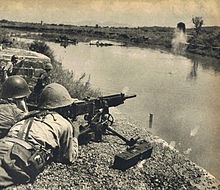Heavy machine gun type 92
| Heavy machine gun type 92 | |
|---|---|

|
|
| general information | |
| Military designation: | Heavy machine gun type 92 |
| Country of operation: |
|
| Developer / Manufacturer: | Nambu Kijirō |
| Development year: | 1932 |
| Manufacturer country: |
|
| Production time: | 1932 to 1941 |
| Weapon Category: | Heavy machine gun |
| Furnishing | |
| Overall length: | 1156 mm |
| Weight: (unloaded) | 55 kg |
| Barrel length : | 721 mm |
| Technical specifications | |
| Caliber : | 7.7 × 58 mm type 92 |
| Possible magazine fillings : | 30 cartridges |
| Ammunition supply : | Metal strips |
| Cadence : | 400-450 rounds / min |
| Fire types: | Continuous fire |
| Number of trains : | 4th |
| Twist : | right |
| Visor : | open sights |
| Closure : | Tilt block closure |
| Charging principle: | Gas pressure charger |
| Lists on the subject | |
The heavy machine gun Type 92 ( jap. 九二式重機関銃 Kyūni-shiki jū-kikanjū) is an air-cooled heavy gas operated - machine gun that from 1932 the Imperial Japanese Army and the Imperial Japanese Navy was in use. It was based on the design of the Hotchkiss M1914 and was the successor to the Type 3 heavy machine gun . The Type 92 was the most widely used machine gun by Japanese soldiers in World War II . The cadence of the weapon was relatively slow with 400 to 450 rounds per minute and produced a characteristic sound, which is why the weapon of the Allies "Woodpecker" ( Specht ) was called. The Chinese soldiers called the machine gun "chicken neck" because of the appearance of the barrel. The designation type 92 refers to the year of introduction within the Japanese calendar scheme in the year 2592 - in the Gregorian calendar the year 1932.
design

The Type 92 fires the 7.7 × 58 mm cartridge instead of the 6.5 × 50 mm of its predecessor. The larger caliber was introduced at the request of the military in order to be able to combat fortified positions and lightly armored vehicles. Another improvement was the addition of two retractable pistol grips for guiding the weapon. In contrast to Type 3, Type 92 had a safety device that could be operated with the thumb. Like the Type 3, the Type 92 has two different sights: a retractable reflex sight for use as an anti-aircraft machine gun and an open sight on the right side of the barrel, the telescopic sight of which could be adjusted from 300 to 2700 meters. Both visors were permanently attached.
The effective range is given as 800 meters. Various optical sights such as a periscope or a telescopic sight could be attached. The Type 92, including the tripod, was carried by three or four soldiers on special handles and was immediately ready for use after the weapon was set down.
Although the weapon was robust and accurate, there were problems that made the weapon less effective. The cartridge strip only held 30 rounds and was quickly fired. Loading could easily jam when reloading . To counteract this, the bullets were given a light oiling during production. However, this made the problem even worse as the oiled cartridges attracted dirt and this contaminated the weapon. The result was even more jams.
Type 92 was manufactured by Tokyo Gas and Electric , among others .
The direct successor to the Type 92 was the Type 1 heavy machine gun , in which the weight of the weapon was reduced by almost 50%.
literature
- James H. Willbanks Machine Guns: An Illustrated History of Their Impact
- Günter Wollert, Reiner Lidschun, Wilfried Copenhagen : small arms . (1945-1985). In: Illustrated encyclopedia of rifles from around the world . 5th edition. tape 1 + 2 . Brandenburgisches Verlagshaus, Berlin 1988, ISBN 3-89488-057-0 , weapons, p. 345-347 .
- David Miller: Fighting Men of World War II, Axis Forces . Uniforms, Equipment & Weapons of Axis Forces. 1st edition. Stackpole Books, 2007, ISBN 978-0-8117-0277-5 , Japan, pp. 284 .
Web links
- Japanese Machine Guns , English
- Handbook on Japanese Military Forces , English
- Type 92 on Military Factory , English
- 日本 軍 三年 式 と 九二 式 重 機関 銃 Type 3 & Type 92 Heavy Machine Gun. YouTube, accessed May 13, 2015 (Japanese).
Individual evidence
- ↑ Small Arms Defense Journal , English

